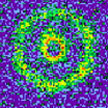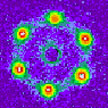For Immediate Release
Brown-led team observes melting in a superconductor
Researchers from Brown University and the National Institute of Standards and Technology are the first to directly observe the melting of a vortex lattice in a superconductor. Their discovery provides a model for the study of melting, a physical phenomenon that has eluded generations of physicists.
PROVIDENCE, R.I. — How do solids melt? Scientists have been trying to answer this deceivingly simple question for years. Now a team of researchers led by Brown University physicist Sean Ling has made a breakthrough discovery in a superconductor that will lead physicists closer to answering that question.
The team of Brown researchers, with colleagues from the National Institute of Standards and Technology in Gaithersburg, Md., are the first to show that swirling electrons, tightly packed in so-called quantized vortices, can literally melt or freeze just like ice or water. The results were published in Physical Review Letters on Jan. 22. The work also will be presented by Ling and graduate student Sang Ryul Park during the American Physical Society meeting in Seattle, at 11 a.m. Monday, March 12, 2001, in the Washington State Convention Center, Room 616.
Ling and colleagues worked with a single crystal of the metal niobium, commonly used in magnets for MRI machines. The metal is a superconductor – it carries electric current without a loss of energy – at low temperatures.
The team took a cylinder of niobium 1 inch long by one-half inch in diameter and put it in a magnetic field, which causes the formation of vortices – swirling eddies of billions of Cooper pairs of electrons. Then, the metal was heated to see whether the vortex lattice would melt.

 To create photographic evidence of melting, Ling’s team beamed billions
of neutrons through the top of the cylinder. At the other end of the tunnel, the light formed spots when the vortices were solid (right), then a ring, which showed the scientists that the vortices had melted into a liquid (far right). The vortices were frozen solid at 4.1 degrees Kelvin and melted at 4.8 degrees Kelvin. (Photos of the melting are available at
http://www.physics.brown.edu/users/faculty/xsling/ling_group/melt.jpg).
To create photographic evidence of melting, Ling’s team beamed billions
of neutrons through the top of the cylinder. At the other end of the tunnel, the light formed spots when the vortices were solid (right), then a ring, which showed the scientists that the vortices had melted into a liquid (far right). The vortices were frozen solid at 4.1 degrees Kelvin and melted at 4.8 degrees Kelvin. (Photos of the melting are available at
http://www.physics.brown.edu/users/faculty/xsling/ling_group/melt.jpg).
“This is of fundamental interest to physicists because it provides a playground for studying the phenomenon of melting,” Ling said. “It’s a common phenomenon, but understanding of this has evaded generations of physicists. Now we can actually use superconductors as a model system to study the mechanism of melting – it paves the way for future studies.”
The experiment also showed that the melting occurs at the same time as the superconductor’s well-known “peak effect,” a sudden increase of critical current followed by a sudden decrease. The higher current-carrying capability is thought to be caused by a softening of the vortex lattice into a Jell-O like consistency.
The research team includes Ling, Park and undergraduate Bridget McClain of Brown University and Sungmin Choi, Daniel Dender and Jeffrey Lynn of the National Institute of Standards and Technology in Gaithersburg, where the neutron-producing nuclear reactor is maintained by the U.S. Department of Commerce.
The work was supported by grants from the National Science Foundation, the A.P. Sloan Foundation, and a Brown University Salomon Award.
######

